Influence of Compounding Parameters on the Tensile Properties and Fibre Dispersion of Injection-Moulded Polylactic Acid and Thermomechanical Pulp Fibre Biocomposites
Abstract
1. Introduction
2. Materials and Methods
2.1. Raw Materials
2.2. Compounding
2.3. Injection Moulding
2.4. Tensile Tests
2.5. Statistical Analysis
2.6. Melt Flow Index
2.7. Scanning Electron Microscopy
2.8. Dynamic Mechanical Analysis
2.9. X-ray Micro-Computed Tomography
3. Results and Discussion
3.1. Tensile Tests
3.2. Statistical Analysis
3.3. Melt Flow Index
3.4. Dynamic Mechanical Analysis
3.5. Scanning Electron Microscopy
3.6. X-ray Micro-Computed Tomography
4. Conclusions
Author Contributions
Funding
Institutional Review Board Statement
Informed Consent Statement
Data Availability Statement
Acknowledgments
Conflicts of Interest
Abbreviations
| ANOVA | Analysis of variance |
| DMA | Dynamic mechanical analysis |
| DoE | Design of experiments |
| PLA | Poly(lactic acid) |
| S | Industrial side stream |
| SEM | Scanning electron microscopy |
| Tg | Glass transition temperature |
| TMP | Thermomechanical pulp |
| X-CT | X-ray microtomography |
References
- Peltola, H.; Laatikainen, E.; Jetsu, P. Effects of physical treatment of wood fibres on fibre morphology and biocomposite properties. Plast. Rubber Compos. 2011, 40, 86–92. [Google Scholar] [CrossRef]
- Chinga-Carrasco, G.; Zarna, C.; Rodríguez-Fabià, S.; Leirset, I.; Tanase-Opedal, M.; Molteberg, D.; Echtermeyer, A.; Hindersland, L.K. Side streams from flooring laminate production—Characterisation and recycling in biocomposite formulations for injection moulding. Compos. Part A Appl. Sci. Manuf. 2022, 153, 106723. [Google Scholar] [CrossRef]
- Tao, Y.; Wang, H.; Li, Z.; Li, P.; Shi, S.Q. Development and Application of Wood Flour-Filled Polylactic Acid Composite Filament for 3D Printing. Materials 2017, 10, 339. [Google Scholar] [CrossRef] [PubMed]
- Pilla, S.; Gong, S.; O’Neill, E.; Yang, L.; Rowell, R.M. Polylactide-recycled wood fiber composites. J. Appl. Polym. Sci. 2009, 111, 37–47. [Google Scholar] [CrossRef]
- Tarrés, Q.; Melbø, J.K.; Delgado-Aguilar, M.; Espinach, F.X.; Mutjé, P.; Chinga-Carrasco, G. Micromechanics of Tensile Strength of Thermo-mechanical Pulp Reinforced Poly(lactic) Acid Biodegradable Composites. J. Nat. Fibers 2022, 1–14. [Google Scholar] [CrossRef]
- Dufresne, A. 8-Cellulose-Based Composites and Nanocomposites. In Plastics Design Library; Ebnesajjad, S.B.T.H.o.B., Plastics, B., Eds.; William Andrew Publishing: Boston, MA, USA, 2013; pp. 153–169. [Google Scholar] [CrossRef]
- Joffre, T.; Miettinen, A.; Berthold, F.; Gamstedt, E.K. X-ray micro-computed tomography investigation of fibre length degradation during the processing steps of short-fibre composites. Compos. Sci. Technol. 2014, 105, 127–133. [Google Scholar] [CrossRef]
- Stanciu, M.D.; Teodorescu Draghicescu, H.; Tamas, F.; Terciu, O.M. Mechanical and Rheological Behaviour of Composites Reinforced with Natural Fibres. Polymers 2020, 12, 1402. [Google Scholar] [CrossRef]
- Bourmaud, A.; Shah, D.U.; Beaugrand, J.; Dhakal, H.N. Property changes in plant fibres during the processing of bio-based composites. Ind. Crop. Prod. 2020, 154, 112705. [Google Scholar] [CrossRef]
- Zarna, C.; Opedal, M.T.; Echtermeyer, A.T.; Chinga-Carrasco, G.; Ngo, T.D.; Kashani, A.; Imbalzano, G.; Nguyen, K.T.Q.; Hui, D.; Shahrubudin, N.; et al. Reinforcement ability of lignocellulosic components in biocomposites and their 3D printed applications—A review. Compos. Part C Open Access 2019, 143, 100171. [Google Scholar] [CrossRef]
- Codari, F.; Lazzari, S.; Soos, M.; Storti, G.; Morbidelli, M.; Moscatelli, D. Kinetics of the hydrolytic degradation of poly(lactic acid). Polym. Degrad. Stab. 2012, 97, 2460–2466. [Google Scholar] [CrossRef]
- Yang, X.; Wang, G.; Miao, M.; Yue, J.; Hao, J.; Wang, W. The Dispersion of Pulp-Fiber in High-Density Polyethylene via Different Fabrication Processes. Polymers 2018, 10, 122. [Google Scholar] [CrossRef] [PubMed]
- Yang, T.C. Effect of Extrusion Temperature on the Physico-Mechanical Properties of Unidirectional Wood Fiber-Reinforced Polylactic Acid Composite (WFRPC) Components Using Fused Deposition Modeling. Polymers 2018, 10, 976. [Google Scholar] [CrossRef] [PubMed]
- Van de Voorde, B.; Katalagarianakis, A.; Huysman, S.; Toncheva, A.; Raquez, J.M.; Duretek, I.; Holzer, C.; Cardon, L.; Bernaerts, K.V.; Van Hemelrijck, D.; et al. Effect of extrusion and fused filament fabrication processing parameters of recycled poly(ethylene terephthalate) on the crystallinity and mechanical properties. Addit. Manuf. 2022, 50, 102518. [Google Scholar] [CrossRef]
- Hasook, A.; Muramatsu, H.; Tanoue, S.; Iemoto, Y.; Unryu, T. Preparation of nanocomposites by melt compounding polylactic acid/polyamide 12/organoclay at different screw rotating speeds using a twin screw extruder. Polym. Compos. 2008, 29, 1–8. [Google Scholar] [CrossRef]
- Pötschke, P.; Villmow, T.; Krause, B. Melt mixed PCL/MWCNT composites prepared at different rotation speeds: Characterization of rheological, thermal, and electrical properties, molecular weight, MWCNT macrodispersion, and MWCNT length distribution. Polymer 2013, 54, 3071–3078. [Google Scholar] [CrossRef]
- Mayoral, B.; Lopes, J.; McNally, T. Influence of Processing Parameters During Small-Scale Batch Melt Mixing on the Dispersion of MWCNTs in a Poly(propylene) Matrix. Macromol. Mater. Eng. 2014, 299, 609–621. [Google Scholar] [CrossRef]
- Feldmann, M.; Heim, H.P.; Zarges, J.C. Influence of the process parameters on the mechanical properties of engineering biocomposites using a twin-screw extruder. Compos. Part A Appl. Sci. Manuf. 2016, 83, 113–119. [Google Scholar] [CrossRef]
- Irfan, M.S.; Umer, R.; Rao, S. Optimization of Compounding Parameters for Extrusion to Enhance Mechanical Performance of Kenaf-Polypropylene Composites. Fibers Polym. 2021, 22, 1378–1387. [Google Scholar] [CrossRef]
- De Santis, F.; Pantani, R. Melt compounding of poly (Lactic Acid) and talc: Assessment of material behavior during processing and resulting crystallization. J. Polym. Res. 2015, 22, 242. [Google Scholar] [CrossRef]
- Rüppel, A.; Wolff, S.; Oldemeier, J.P.; Schöppner, V.; Heim, H.P. Influence of Processing Glass-Fiber Filled Plastics on Different Twin-Screw Extruders and Varying Screw Designs on Fiber Length and Particle Distribution. Polymers 2022, 14, 3113. [Google Scholar] [CrossRef]
- Peltola, H.; Pääkkönen, E.; Jetsu, P.; Heinemann, S. Wood based PLA and PP composites: Effect of fibre type and matrix polymer on fibre morphology, dispersion and composite properties. Compos. Part A Appl. Sci. Manuf. 2014, 61, 13–22. [Google Scholar] [CrossRef]
- Muthuraj, R.; Misra, M.; Defersha, F.; Mohanty, A.K. Influence of processing parameters on the impact strength of biocomposites: A statistical approach. Compos. Part Appl. Sci. Manuf. 2016, 83, 120–129. [Google Scholar] [CrossRef]
- Gamon, G.; Evon, P.; Rigal, L. Twin-screw extrusion impact on natural fibre morphology and material properties in poly(lactic acid) based biocomposites. Ind. Crop. Prod. 2013, 46, 173–185. [Google Scholar] [CrossRef]
- Huda, M.S.; Drzal, L.T.; Misra, M.; Mohanty, A.K. Wood-fiber-reinforced poly(lactic acid) composites: Evaluation of the physicomechanical and morphological properties. J. Appl. Polym. Sci. 2006, 102, 4856–4869. [Google Scholar] [CrossRef]
- Asadollahzadeh, M.; Mahboubi, A.; Taherzadeh, M.J.; Åkesson, D.; Lennartsson, P.R. Application of Fungal Biomass for the Development of New Polylactic Acid-Based Biocomposites. Polymers 2022, 14, 1738. [Google Scholar] [CrossRef] [PubMed]
- Hijazi, N.; Le Moigne, N.; Rodier, E.; Sauceau, M.; Vincent, T.; Benezet, J.C.; Fages, J. Biocomposite films based on poly(lactic acid) and chitosan nanoparticles: Elaboration, microstructural and thermal characterization. Polym. Eng. Sci. 2019, 59, E350–E360. [Google Scholar] [CrossRef]
- Krishnaprasad, R.; Veena, N.R.; Maria, H.J.; Rajan, R.; Skrifvars, M.; Joseph, K. Mechanical and Thermal Properties of Bamboo Microfibril Reinforced Polyhydroxybutyrate Biocomposites. J. Polym. Environ. 2009, 17, 109. [Google Scholar] [CrossRef]
- Vandi, L.J.; Chan, C.M.; Werker, A.; Richardson, D.; Laycock, B.; Pratt, S. Extrusion of wood fibre reinforced poly(hydroxybutyrate-co-hydroxyvalerate) (PHBV) biocomposites: Statistical analysis of the effect of processing conditions on mechanical performance. Polym. Degrad. Stab. 2019, 159, 1–14. [Google Scholar] [CrossRef]
- Nature Works. Ingeo™ Biopolymer 4043D Technical Data Sheet. 2022. Available online: https://www.natureworksllc.com/~/media/Files/NatureWorks/Technical-Documents/Technical-Data-Sheets/TechnicalDataSheet_4043D_3D-monofilament_pdf-pdf (accessed on 15 September 2022).
- Minitab. Minitab 19 Support. 2022. Available online: https://support.minitab.com/en-us/minitab/21/ (accessed on 4 October 2022).
- Turner, J.R. Introduction to Analysis of Variance: Design, Analysis, & Interpretation; SAGE: Thousand Oaks, CA, USA, 2001. [Google Scholar]
- Miettinen, A.; Luengo Hendriks, C.L.; Chinga-Carrasco, G.; Gamstedt, E.K.; Kataja, M. A non-destructive X-ray microtomography approach for measuring fibre length in short-fibre composites. Compos. Sci. Technol. 2012, 72, 1901–1908. [Google Scholar] [CrossRef]
- Feldkamp, L.A.; Davis, L.C.; Kress, J.W. Practical cone-beam algorithm. J. Opt. Soc. Am.-Opt. Image Sci. Vis. 1984, 1, 612–619. [Google Scholar] [CrossRef]
- Tomasi, C.; Manduchi, R. Bilateral filtering for gray and color images. In Proceedings of the 6th International Conference on Computer Vision (IEEE Cat. No. 98CH36271), Bombay, India, 7 January 1998; pp. 839–846. [Google Scholar] [CrossRef]
- Otsu, N. A threshold selection method from gray level histograms. IEEE Trans. Syst. Man, Cybern. 1979, 9, 62–66. [Google Scholar] [CrossRef]
- Hendriks, C.L.L. Constrained and Dimensionality-Independent Path Openings. Trans. Img. Proc. 2010, 19, 1587–1595. [Google Scholar] [CrossRef] [PubMed]
- Jahne, B. Practical Handbook on Image Processing for Scientific and Technical Applications; CRC Press: Boca Raton, FL, USA, 2004. [Google Scholar]
- Hildebrand, T.; Rüegsegger, P. A new method for the model-independent assessment of thickness in three-dimensional images. J. Microsc. 1997, 185, 67–75. [Google Scholar] [CrossRef]
- Fu, S.Y.; Feng, X.Q.; Lauke, B.; Mai, Y.W. Effects of particle size, particle/matrix interface adhesion and particle loading on mechanical properties of particulate–polymer composites. Compos. Part B Eng. 2008, 39, 933–961. [Google Scholar] [CrossRef]
- Thomason, J.L. The influence of fibre length and concentration on the properties of glass fibre reinforced polypropylene: 5. Injection moulded long and short fibre PP. Compos. Part A Appl. Sci. Manuf. 2002, 33, 1641–1652. [Google Scholar] [CrossRef]
- Thomason, J.L.; Vlug, M.A. Influence of fibre length and concentration on the properties of glass fibre-reinforced polypropylene: 1. Tensile and flexural modulus. Compos. Part A Appl. Sci. Manuf. 1996, 27, 477–484. [Google Scholar] [CrossRef]
- Mallick, P.K. Chapter 5—Thermoplastics and thermoplastic–matrix composites for lightweight automotive structures. In Woodhead Publishing in Materials; Manufacturing for Lightweight Vehicles (Second Edition); Woodhead Publishing: Cambridge, UK, 2021; pp. 187–228. [Google Scholar] [CrossRef]
- Mital, S.K.; Murthy, P.L.N.; Goldberg, R.K. Micromechanics for Particulate-Reinforced Composites. Mech. Compos. Mater. Struct. 1997, 4, 251–266. [Google Scholar] [CrossRef]
- Ariawan, D.; Surojo, E.; Triyono, J.; Purbayanto, I.F.; Pamungkas, A.F.; Prabowo, A.R. Micromechanical analysis on tensile properties prediction of discontinuous randomized zalacca fibre/high-density polyethylene composites under critical fibre length. Theor. Appl. Mech. Lett. 2020, 10, 57–65. [Google Scholar] [CrossRef]
- Neagu, C.; Gamstedt, K.; Berthold, F. Stiffness Contribution of Various Wood Fibers to Composite Materials. J. Compos. Mater. 2006, 40, 663–699. [Google Scholar] [CrossRef]
- Chan, C.M.; Vandi, L.J.; Pratt, S.; Halley, P.; Richardson, D.; Werker, A.; Laycock, B. Composites of Wood and Biodegradable Thermoplastics: A Review. Polym. Rev. 2018, 58, 444–494. [Google Scholar] [CrossRef]
- Lu, J.Z.; Wu, Q.; Negulescu, I.I. Wood-fiber/high-density-polyethylene composites: Compounding process. J. Appl. Polym. Sci. 2004, 93, 2570–2578. [Google Scholar] [CrossRef]
- Viksne, A.; Rence, L.; Kalnins, M.; Bledzki, A.K. The effect of paraffin on fiber dispersion and mechanical properties of polyolefin–sawdust composites. J. Appl. Polym. Sci. 2004, 93, 2385–2393. [Google Scholar] [CrossRef]
- Fazelinejad, S.; Åkesson, D.; Skrifvars, M. Repeated Mechanical Recycling of Polylactic Acid Filled with Chalk. Prog. Rubber, Plast. Recycl. Technol. 2017, 33, 1–16. [Google Scholar] [CrossRef]
- Renstad, R.; Karlsson, S.; Albertsson, A.C. Influence of processing parameters on the molecular weight and mechanical properties of poly(3-hydroxybutyrate-co-3-hydroxyvalerate). Polym. Degrad. Stab. 1997, 57, 331–338. [Google Scholar] [CrossRef]
- Panwar, V.; Pal, K. Chapter 12—Dynamic Mechanical Analysis of Clay–Polymer Nanocomposites; Elsevier: Amsterdam, The Netherlands, 2017; pp. 413–441. [Google Scholar] [CrossRef]
- Saba, N.; Jawaid, M.; Alothman, O.Y.; Paridah, M.T. A review on dynamic mechanical properties of natural fibre reinforced polymer composites. Constr. Build. Mater. 2016, 106, 149–159. [Google Scholar] [CrossRef]
- Muck, D.; Tomc, H.G.; Elesini, U.S.; Ropret, M.; Leskovšek, M. Colour Fastness to Various Agents and Dynamic Mechanical Characteristics of Biocomposite Filaments and 3D Printed Samples. Polymers 2021, 13, 3738. [Google Scholar] [CrossRef]
- Shenoy, A.; Saini, D. Melt flow index: More than just a quality control rheological parameter. Part II. Adv. Polym. Technol. 1986, 6, 125–145. [Google Scholar] [CrossRef]
- Baker, G.L.; Vogel, E.B.; Smith, M.R. Glass Transitions in Polylactides. Polym. Rev. 2008, 48, 64–84. [Google Scholar] [CrossRef]
- Boran, S.; Kiziltas, A.; Kiziltas, E.; Gardner, D. Characterization of Ultrafine Cellulose-filled High-Density Polyethylene Composites Prepared using Different Compounding Methods. BioResources 2016, 11, 8178–8199. [Google Scholar] [CrossRef]
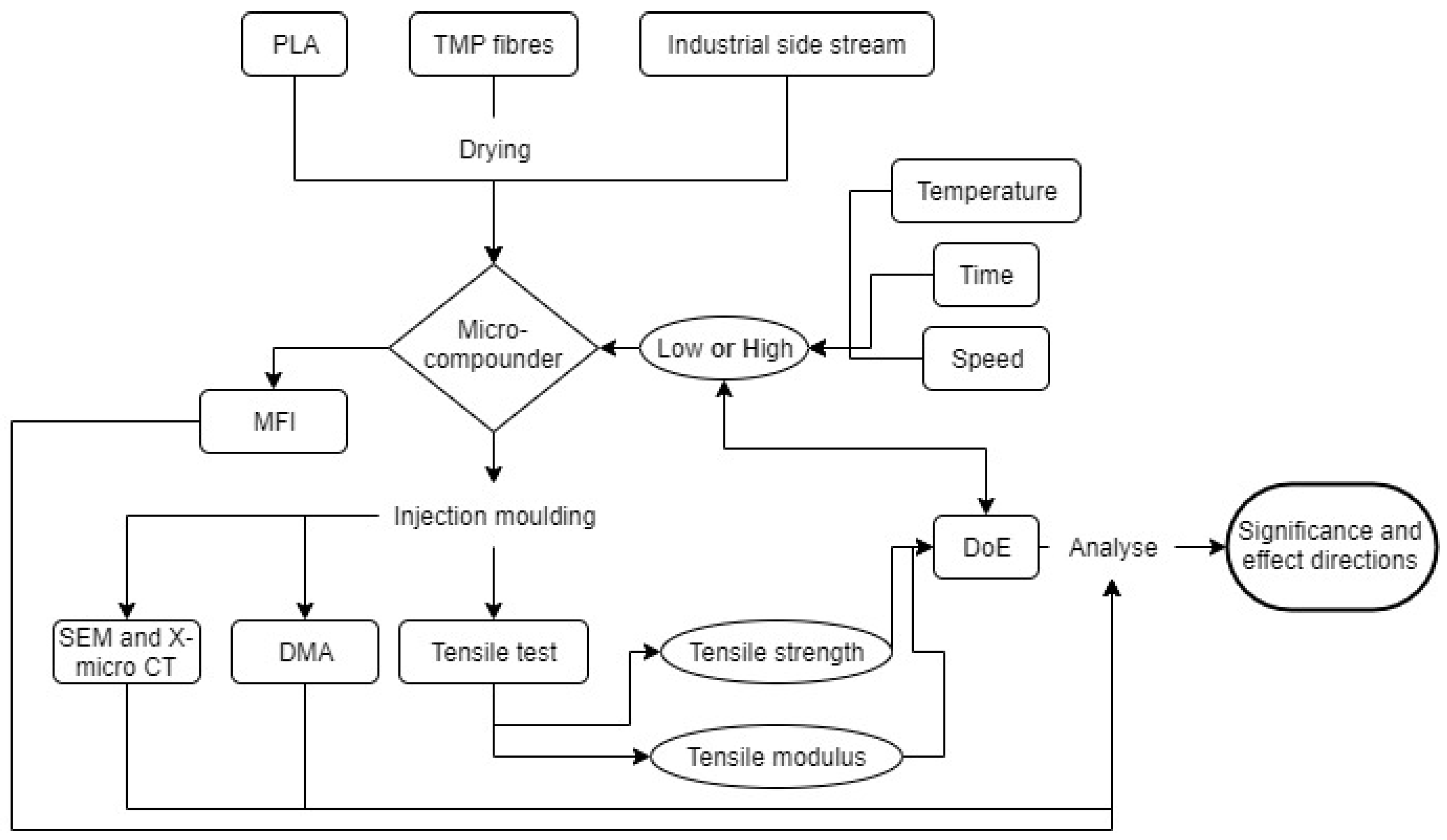


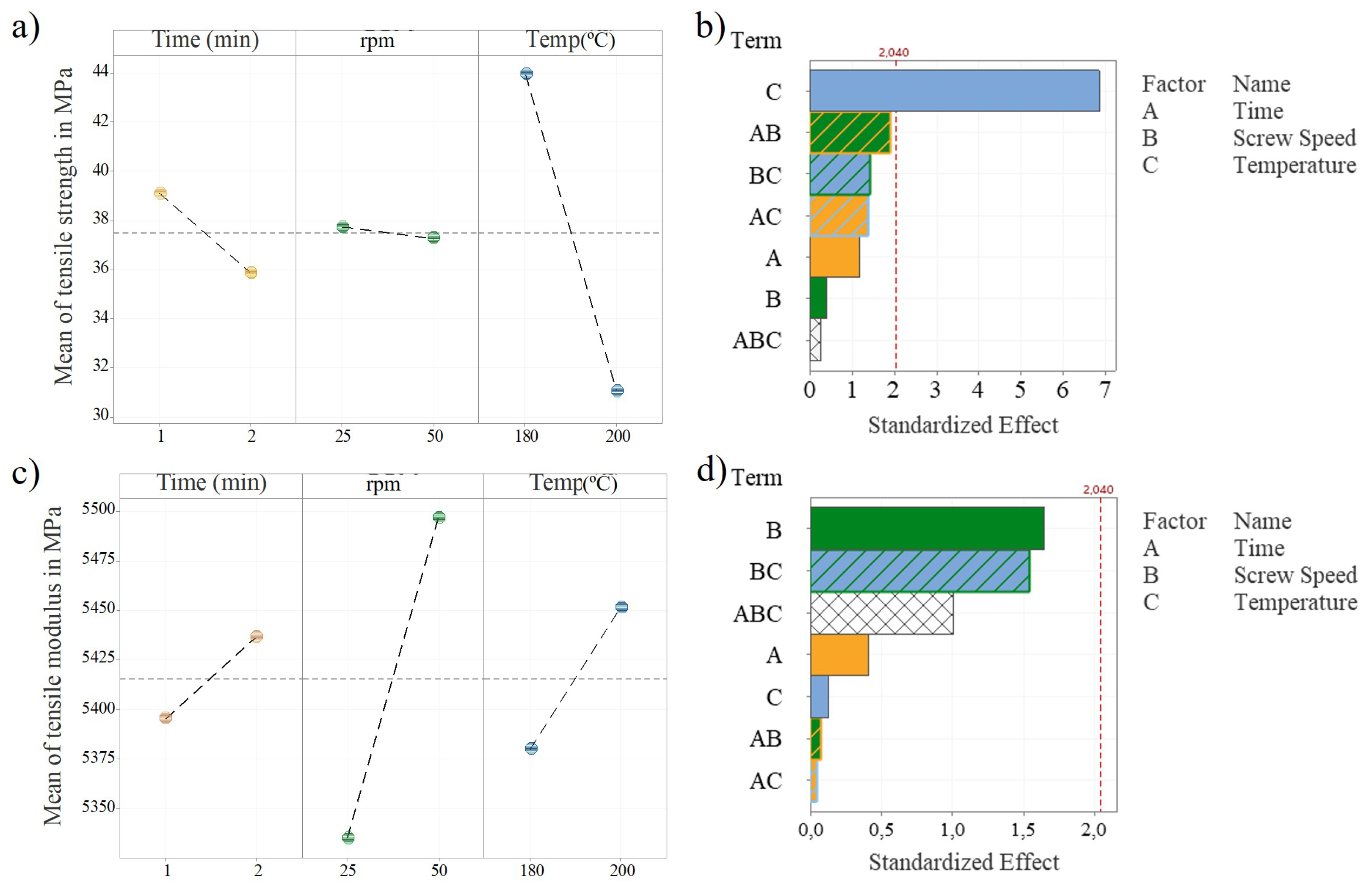
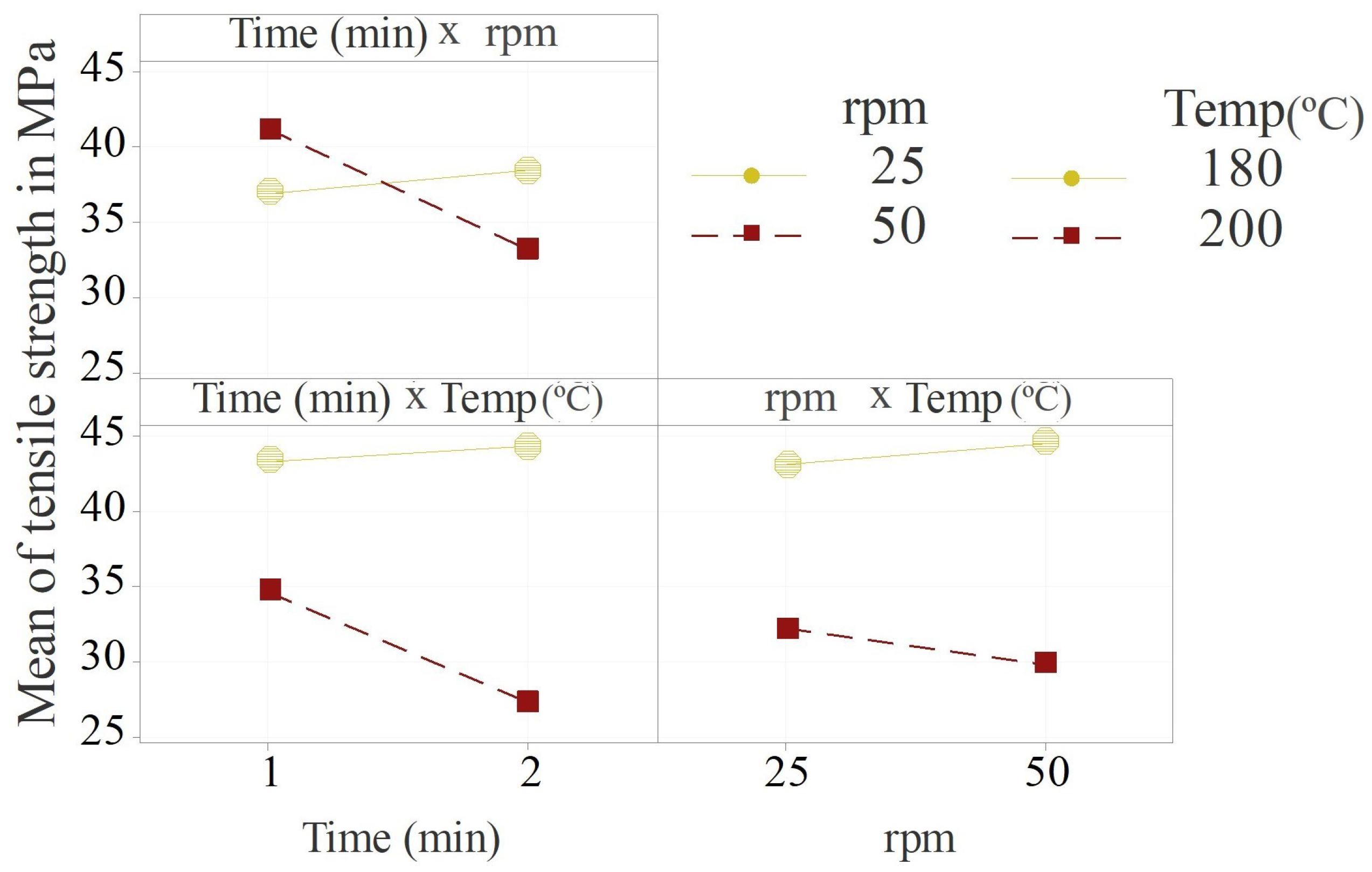
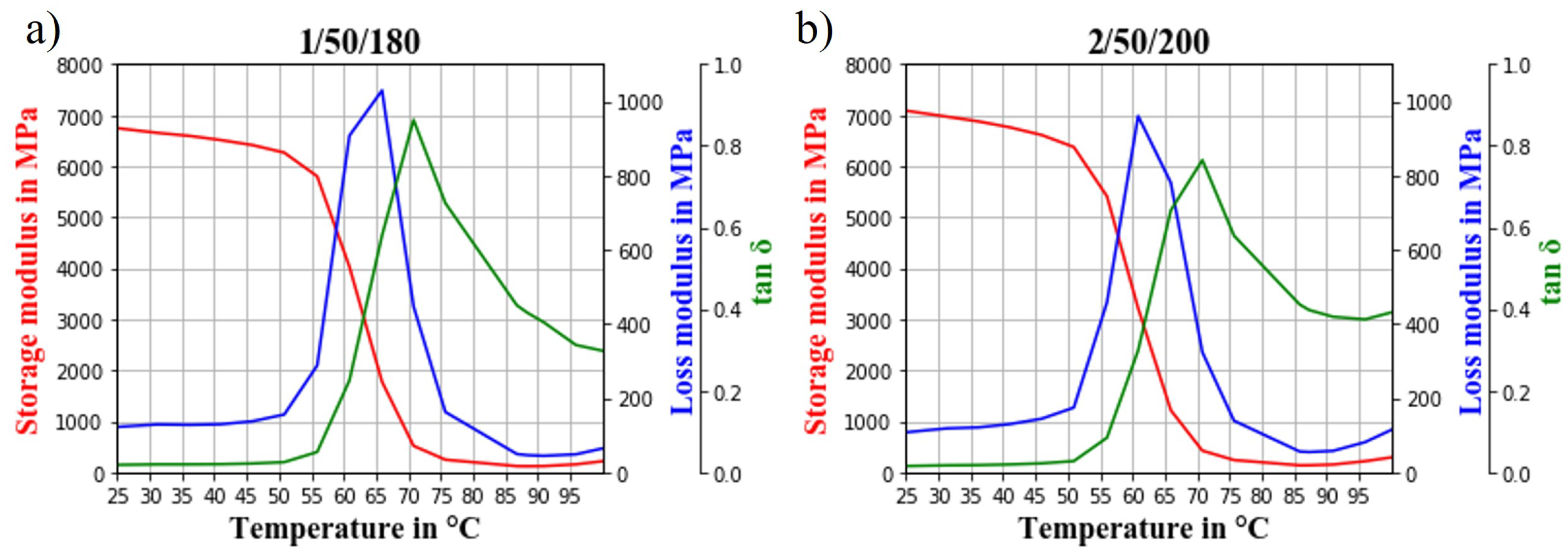
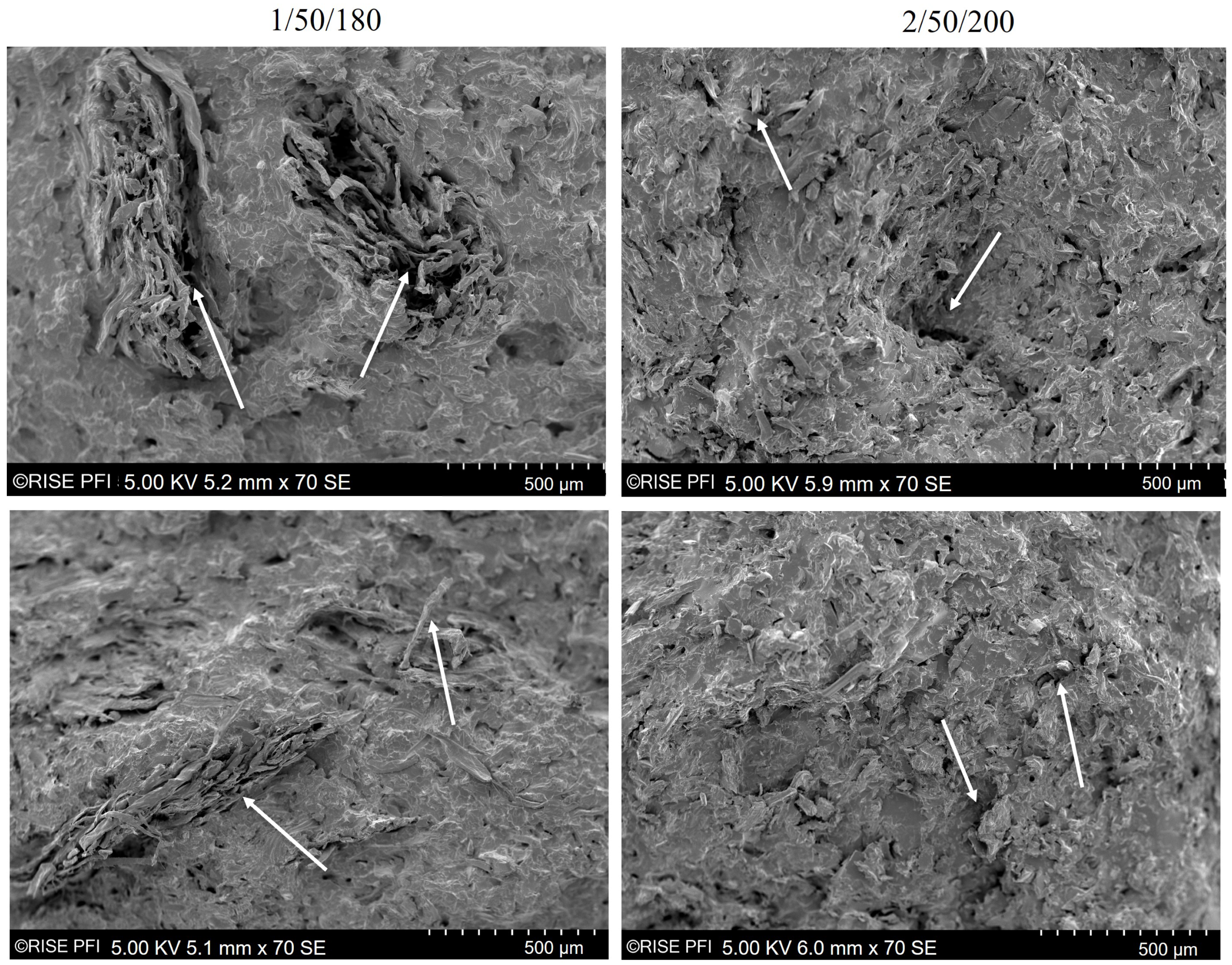

| Series Designation | Time (min) | Speed (rpm) | Temperature (C) | |||
|---|---|---|---|---|---|---|
| Low | High | Low | High | Low | High | |
| 1/25/180 | 1 | 25 | 180 | |||
| 2/25/180 | 2 | 25 | 180 | |||
| 1/50/180 | 1 | 50 | 180 | |||
| 2/50/180 | 2 | 50 | 180 | |||
| 1/25/200 | 1 | 25 | 200 | |||
| 2/25/200 | 2 | 25 | 200 | |||
| 1/50/200 | 1 | 50 | 200 | |||
| 2/50/200 | 2 | 50 | 200 | |||
| Parameter | Value | Unit | Clarification |
|---|---|---|---|
| 0.7 | - | Matrix volume fraction | |
| 0.3 | - | Fibre volume fraction | |
| 3.6 | GPa | Matrix tensile modulus | |
| 2 | GPa | Fibre tensile modulus [46] | |
| 0.375 | - | Fibre orientation factor [42] | |
| - | Fibre length factor [42] | ||
| - | - [42] | ||
| 4.0 | - | Squared packing value [42] | |
| MPa | Matrix shear modulus | ||
| 0.3 | - | Poisson’s ratio of matrix | |
| 66 | MPa | Matrix’s ultimate tensile strength | |
| 500 | MPa | Fibre’s ultimate tensile strength [10] | |
| MPa | Matrix shear strength | ||
| d | 0.02 | mm | Fibre diameter (measured with X-CT) |
| mm | Critical load transfer length [45] | ||
| 0.167 | - | Fibre orientation factor [10] | |
| , | - | Length factor [10] |
| Factor | p-Value | |
|---|---|---|
| Tensile Strength Response | Tensile Modulus Response | |
| Temperature | ≪ 0.05 | 0.683 |
| Speed | 0.695 | 0.110 |
| Time | 0.250 | 0.898 |
| Time × Speed | 0.065 | 0.940 |
| Time × Temperature | 0.175 | 0.962 |
| Speed × Temperature | 0.162 | 0.133 |
| Time × Speed × Temperature | 0.785 | 0.321 |
Publisher’s Note: MDPI stays neutral with regard to jurisdictional claims in published maps and institutional affiliations. |
© 2022 by the authors. Licensee MDPI, Basel, Switzerland. This article is an open access article distributed under the terms and conditions of the Creative Commons Attribution (CC BY) license (https://creativecommons.org/licenses/by/4.0/).
Share and Cite
Zarna, C.; Rodríguez-Fabià, S.; Echtermeyer, A.T.; Chinga-Carrasco, G. Influence of Compounding Parameters on the Tensile Properties and Fibre Dispersion of Injection-Moulded Polylactic Acid and Thermomechanical Pulp Fibre Biocomposites. Polymers 2022, 14, 4432. https://doi.org/10.3390/polym14204432
Zarna C, Rodríguez-Fabià S, Echtermeyer AT, Chinga-Carrasco G. Influence of Compounding Parameters on the Tensile Properties and Fibre Dispersion of Injection-Moulded Polylactic Acid and Thermomechanical Pulp Fibre Biocomposites. Polymers. 2022; 14(20):4432. https://doi.org/10.3390/polym14204432
Chicago/Turabian StyleZarna, Chiara, Sandra Rodríguez-Fabià, Andreas T. Echtermeyer, and Gary Chinga-Carrasco. 2022. "Influence of Compounding Parameters on the Tensile Properties and Fibre Dispersion of Injection-Moulded Polylactic Acid and Thermomechanical Pulp Fibre Biocomposites" Polymers 14, no. 20: 4432. https://doi.org/10.3390/polym14204432
APA StyleZarna, C., Rodríguez-Fabià, S., Echtermeyer, A. T., & Chinga-Carrasco, G. (2022). Influence of Compounding Parameters on the Tensile Properties and Fibre Dispersion of Injection-Moulded Polylactic Acid and Thermomechanical Pulp Fibre Biocomposites. Polymers, 14(20), 4432. https://doi.org/10.3390/polym14204432







